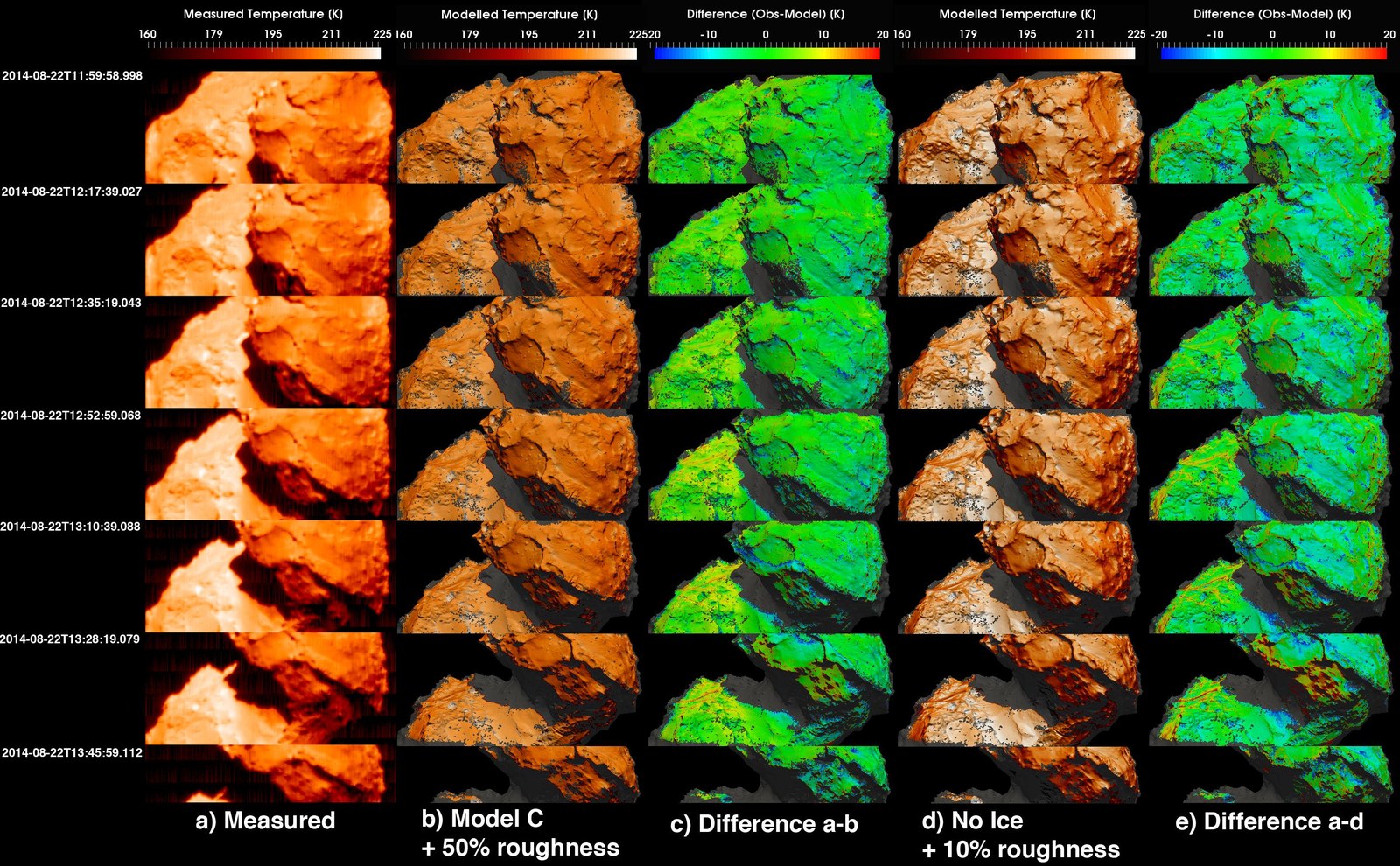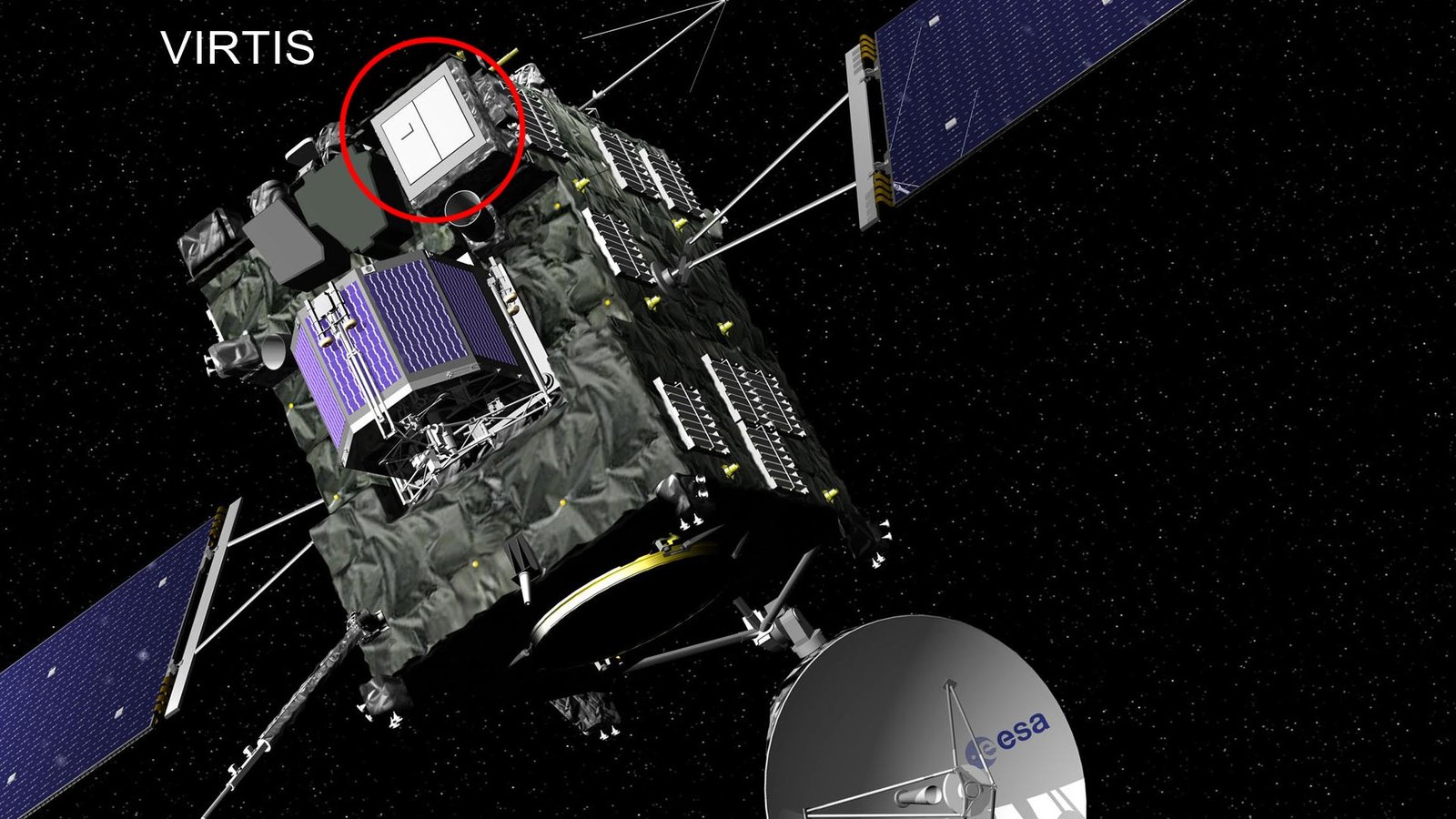Rosetta 'post-mission' – new findings relating to the temperature and nature of the comet's surface



- Some years after the end of the Rosetta mission, scientists are continuing to analyse the data acquired by Rosetta to obtain important insights for comet research and the study of the early Solar System.
- Focus: Spaceflight, exploration
Two-and-a-half years have passed since the operational phase of the Rosetta mission came to an end in September 2016. However, scientific evaluation of the enormous amounts of data from the instruments on the spacecraft and the Philae lander is still ongoing. The team of scientists working on the VIRTIS instrument have now published new findings relating to the surface temperature and thermal effects on the 'duck-shaped' Comet 67P / Churyumov-Gerasimenko in the 22 April 2019 issue of Nature Astronomy. Germany's scientific contributions to VIRTIS are led by the German Aerospace Center (Deutsches Zentrum für Luft- und Raumfahrt; DLR).
The Visible InfraRed and Thermal Imaging Spectrometer (VIRTIS) acquired infrared images of the comet from on board the Rosetta orbiter during August and September 2014, approximately one year before the comet reached perihelion – the point in its orbit closest to the Sun. During the period under consideration, the comet was still distant from the Sun, and its level of activity was low. The researchers converted the images into thermal maps.
Temperature is the most important parameter for deriving the gas and dust activity typical of comets. First, the VIRTIS team measured the average temperature of the comet's nucleus on its daytime side. While the average surface temperature over the two months was approximately minus 60 degrees Celsius, the scientists also identified places that were significantly warmer, at around minus 43 degrees Celsius. These included a cavity in the surface, where the inner walls reflected the thermal radiation and thus led to stronger warming, referred to as self-heating.
Self-heating also occurs at the 'duck's neck' connecting the two lobes of the comet. Temperatures were higher here than the laws of black-body radiation would imply. Assuming a dust-dominated surface a few millimetres thick and minimal sublimation of volatile substances, self-heating is attributable to surface roughness. The self-heating effect is enhanced by the striking concave shape of the 'neck'.
Another significant finding concerns the thermal gradients caused by sudden shadows cast alternately onto the 'neck' by the two lobes of the comet during solar illumination. These localised shadows on the 'neck' created extreme temperature differences within the space of just a few minutes, which might be 10 times greater than normal daily variations in temperature on other areas of the surface. "To better investigate seasonal temperature effects on the nucleus, we concentrated on a region named Imhotep, which is relatively flat and far from the 'neck', and where the self-heating effect is significantly lower," says Gabriele Arnold of the DLR Institute of Planetary Research. "For this area, we compared the observations performed by VIRTIS with those of the Microwave Instrument for the Rosetta Orbiter (MIRO), another instrument on board Rosetta. MIRO made it possible to measure the temperature in larger depressions on the comet. The findings of the two instruments can be explained by the theory that the Imhotep region has a thin surface layer consisting mainly of loose dust."
Imhotep was also observed a few months later, when the comet was much closer to the Sun. The temperature values obtained by VIRTIS were much higher than before, but lower than expected, given that the scientists were working on the assumption that the surface layer consisted only of loose dust. This led the researchers to conclude that the composition of the uppermost layers must have changed over time. The quantity of volatiles within it must have increased, resulting in a higher degree of sublimation and more intense comet activity. This in turn can cause surface temperatures to be lower than would be reached by a layer consisting solely of dust.
All the observational evidence suggests a comet nucleus with thermal behaviour that is dominated by phenomena associated with the morphology and chemical and physical state of the thin uppermost surface layer, which is only a few centimetres thick. In the subsurface, the nucleus is thought to remain essentially unchanged and has only been weakly influenced by previous approaches to the Sun.
Gabriele Arnold sums up: "The work that has just been published shows that the ongoing evaluation of the large quantity of data acquired will continue to provide unique findings for comet research and the study of the early Solar System, even years after the end of the Rosetta mission."
- The Rosetta comet mission
After more than 20 years of scientists and engineers working on the Rosetta mission, the 10-year journey to Comet 67P / Churyumov-Gerasimenko and nearly two years of scientific data acquisition from orbit and on the surface by the Philae lander, the operational part of the mission came to an end in September 2016; in other words, #GoodbyePhilae.
Rosetta was the first space mission to closely accompany a comet on its journey around the Sun. Among the many discoveries made about Comet 67P, Rosetta performed direct and repeated measurements of the surface temperature of a comet nucleus with an unprecedented spatial resolution. From this, the thermal properties and activity patterns of the nucleus could be derived. - About VIRTIS
The VIRTIS instrument on board the Rosetta orbiter acquired infrared images of the comet nucleus, which were converted into thermal maps. This allowed changes in the temperature of the nucleus to be continuously studied for almost two months in late summer 2014, around a year before the comet reached perihelion.
VIRTIS has provided information on the composition of the comet's nucleus and the distribution of material on its surface, and the gases and molecules within the coma. VIRTIS was built by a consortium of teams under the scientific leadership of the Istituto di Astrofisica e Planetologia Spaziali (IAPS) at the Italian National Institute for Astrophysics (Istituto Nazionale di Astrofisica; INAF) in Rome, which was also in charge of scientific operations. The consortium included the Laboratoire d'Études Spatiales et d'Instrumentation en Astrophysique (LESIA) at the Observatoire de Paris in France, and the DLR Institute of Planetary Research in Germany.
The development of the instrument was funded and coordinated by the various national space agencies: Agenzia Spaziale Italiana (ASI, Italy), Centre National d’Études Spatiales (CNES, France) and DLR (Germany). The mission was supported by the Rosetta Science Ground Segment and the Rosetta Mission Operations Centre.
